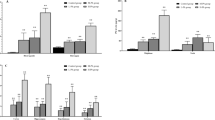Abstract
Newborn rat pups were treated in seven groups: Group 1, the control, was untreated and killed at birth (day 1); Groups 2, 3, and 4 were treated on postnatal days 1 through 10 with respectively saline or lead acetate, 5.0 mg/kg and 7.5 mg/kg body weight; Groups 5, 6, and 7 were treated with the same respective dosages on days 11 through 20. Cerebellum, cerebral cortex, brainstem plus hippocampus, liver, and blood were analyzed for lead. Neonatal rats killed at birth all contained some lead, the cerebellum having the highest concentration. Tissue from most treated groups accumulated lead in a dose-dependent manner. A comparison of lead concentrations between the organs of rats dosed days 1–10 and rats dosed days 11–20 indicated that the latter accumulated less lead per gram of tissue (p < 0.05) than their younger litter mates.
Similar content being viewed by others
References
Barltrop D (1976) Subclinical lead poisoning in children. J Child Psychol Psychiatr 17: 225–227
Brown DR (1975) Neonatal lead exposure in the rat; decreased learning as a function of age and blood lead concentrations. Toxicol Appl Pharmacol 32: 628–637
Browning E (1969) Toxicology of Industrial Metals, 2nd ed. Butterworth, London
Byers RK (1959) Lead poisoning: Review. Pediatrics 23: 585–603
Chasen RA, Hartman J, Coogan P, Passdolfi S, Laing I, Becker RA (1974) Experimental acute lead encephalopathy in the juvenile rhesus monkey. Environ Health Perspect 7: 175–185
Danscher G, Fjerdingstad EJ, Fjerdingstad E, Fredens K (1976) Heavy metal content in subdivisions of the rat hippocampus (zinc, lead, and copper). Brain Res 112: 442–446
Fjerdingstad EJ, Danscher G, Fjerdingstad E (1974) Hippocampus: Selective concentration of lead in the normal rat brain. Brain Res 80: 350–354
Fullerton PM (1969) Chronic neuropathy produced by lead poisoning in guinea pigs. J Neuropath Exp Neurol 25: 214–236
Goldstein GW, Asbury AK, Diamond I (1974) Pathogenesis of lead encephalopathy, uptake of lead and reaction of brain capillaries. Arch Neurol 31: 382–389
Hammond P (1969) Lead poisoning. In: Blood FR (ed) Essays in toxicology. Academic Press, New York, pp 115–155
Lancet (Editorial) (1973) Subclinical lead poisoning. January, p 87
Lefauconnier JM, Lavielle E, Terrien N, Bernard G, Fournier E (1980) Effect of various lead doses on some cerebral capillary functions in the suckling rat. Toxicol Appl Pharmacol 55: 467–476
Louis-Ferdinand RT, Brown DR, Fiddler S, Daughtrey WC, Klein AW (1978) Morphometric and enzymatic effects of neonatal lead exposure in the rat brain. Toxicol Appl Pharmacol 43: 351–360
Needleman HL (1975) How much lead is too much? The New Republic, January 25, pp 12–13
Passow H, Rothstein A, Clarkson TW (1961) The general pharmacology of the heavy metals. Pharmacol Rev 13: 185–225
Pentschew A (1965) Morphology and morphogenesis of lead encephalopathy. Acta Neuropathol (Berl) 5: 113–160
Pentschew A, Garro F (1966) Lead encephalomyelopathy of the suckling rat and its implications on the porphyrinpathic nervous diseases with special references to the permeability disorders of the nervous systems capillaries. Acta Neuropathol (Berl) 6: 266–278
Popoff N, Weinberg S, Feigin L (1963) Pathologic observation in lead encephalopathy with special reference to vascular changes. Neurology 13: 101–112
Reiter L, Anderson G, Laskey J, Cahill D (1975) Developmental and behavioral changes in the rat during chronic exposure to lead. Environ Health Perspect 12: 119–123.
Sauerhoff M, Michaelson IA (1973) Hyperactivity and brain catecholamines in lead exposed developing rats. Science 182: 1022–1024
Silbergeld EK, Chisolm JJ (1976) Lead poisoning: Altered urinary catecholamine metabolites as indicators of intoxication in mice and children. Science 192: 153–155
Silbergeld EK, Wolinski JS, Goldstein GW (1980) Electron probe microanalysis of isolated brain capillaries poisoned with lead. Brain Res 189: 369–376
Sobotka TJ, Brodie RD, Cook MP (1975) Psychophysiologic effects of early lead exposure. Toxicology 5: 175–191
Weinreich K, Stelle W, Bitsch I (1977) Effect of lead acetate on the spontaneous activity of young rats. 2nd Eur Nutr Conference, Munich 1976. Nutr Metab [Suppl 1] 21: 201–203
Author information
Authors and Affiliations
Rights and permissions
About this article
Cite this article
Klein, A.W., Koch, T.R. Lead accumulations in brain, blood, and liver after low dosing of neonatal rats. Arch Toxicol 47, 257–262 (1981). https://doi.org/10.1007/BF00332391
Received:
Issue Date:
DOI: https://doi.org/10.1007/BF00332391




